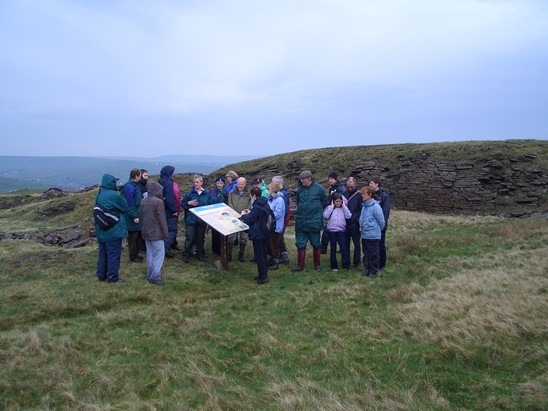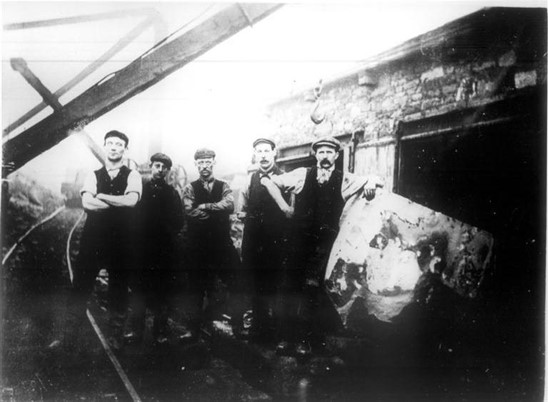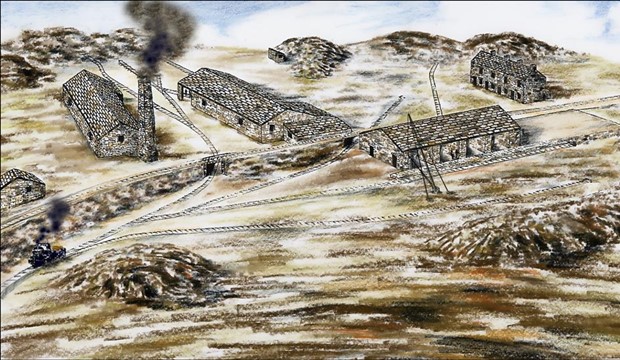Cloughfold Scrubbing Mill showing processing works
Cloughfold Scrubbing Mill showing top of the incline
Cloughfold Scrubbing Mill is located at NGR: SD 818 218 and is positioned on the junction of a series of mineral tramways. The site can be accessed from a public footpath from Cloughfold, which follows the line of a tramway incline. The Cloughfold Mill is an exceptional archaelogical site and one of the most important industrial processing remains in Rossendale.
Historical Summary
Working life: Post 1849 (OS 6” 1st edn map)/pre- 1894 (OS 6” 2nd edn map). Its construction may be contemporary with construction of the tramway system in 1867. Probably disused by 1920 when the track of the Cloughfold – Ding tramway lifted ('Making Tracks' Groundwork Rossendale Document, 1999)
Quarry firms: Butterworth & Brooks. Brooks & Brooks.
Methods: Steam-powered machinery. Hand dressed stone.
Transport: The tramway moved material from the quarry and scrubbing mill to the main railway at Clough Fold. A system of tramways also connected the mill with Cragg, Ding, Great Height, Hurdles and Brow Edge quarries.
Products: Building stone, stone flags.
Events:
09.02.1867 Thomas Greenwood had his leg broken below the knee on the quarry incline. He was riding on the third wagon of three when the front wagons became loose and rolled back and struck him breaking his leg.
03.10.1868 A young man in charge of wagons bringing stone from the quarries was killed when the brakes and sprags failed and the wagons went out of his control.
23.11.1867 Robert Dawson, 55, was killed while oiling rollers on the tramway wire haul rope. He was struck by the full wagons coming down the incline and carried 20 yards before the wagons stopped. Both legs and his right arm were broken and his back and head were cut and bruised. He died later of his injuries.
15.12.1877 James Rawlins and Samuel Payne were injured when a copper chain attached to three laden wagons broke. The two men, along with two others who were uninjured had been riding the wagons and jumped off. The rock flew from the wagon and injured Edward Croasdale who would need amputation of one or two limbs.
29.07.1882 Patrick Callaghan, farm labourer, suffered a crushed right arm as he tried to jump onto empty wagons.
02.08.1884 Two laden wagons were descending the incline when the rope broke and they ran down the slope until eventually coming to a standstill. Little damage was done.
15.08.1885 Five anvils offered for sale from Whinberry Naze. One for double blasted bellows, tongs, top and bottom steel swages, swage blocks, vice, screwing tackle, quantity of iron and steel.
13.06.1889 Goodshaw Church rambling club visited the mills. The stones are prepared by putting a layer of stone on a circular ring of iron with another set of stones on top and are fastened by iron bands. They are turned in opposite directions to polish them.
04.08.1888 Three laden wagons left the track after the wire haul rope parted. The wagons dropped into the road leading to Victoria Buildings, two of the upright pillars by which the bridge over that road can be raised when required were snapped off, the sleepers on the bridge were broken. A stone smashed through a panel of the office door adjoining and a considerable amount of damage was done.
07.12.1895 William Fields was loading flags onto a wagon when some of the flags fell breaking both bones in one leg. He was taken to Manchester Infirmary by train.
05.04.1899 A fatal accident occurred to John Isaac Ashford, 22. When accompanying laden wagons with another man a stone fell under the wheels of a wagon tipping it, and the deceased, onto the road below. The wagon had fallen on his head and he died a short time later.
23.01.1909 Martin Varley was going home along the tramway when a link broke on the wire haul rope. Portions of the link flew up and hit him on the leg causing a compound fracture.
16.10.1920 References to the sale of cranes, wagons and other appliances for Brooks Cloughfold Quarries. Includes two locomotives and the railway they formerly run over. Tearing up the railway will remove one of the features on the further side of Cowpe Lowe. The track was laid about 1844-5 and runs from the top of the tramway at Cloughfold, along the breast of the hill around Foe Edge Farm to Cragg Quarry. One spur runs to Ding Quarry and then the quarries at Britannia. Over 5 miles long. Before the railway the stone was conveyed on horse drawn sledges over Rooley Moor and down to Rochdale and Heywood. The quarries were closed at the outbreak of war and very little work has occurred there since. The railroad is now being torn up and the buildings and quarry plant dismantled.
29.10.1932 Demolition of a large wooden bridge on the east side of Cloughfold crossing. Bridge formerly used for carrying a tramway from Brooks & Brooks Quarry over the River Irwell to the Cloughfold railway sidings.

Summary of Surviving Remains
This mill site contains a series of ruinous structures and features which are related to both the processing and movement of stone. The structures include a building which may have been used as a dwelling, a structure which appears to have acted as a polishing mill and boiler house, and a structure which probably housed three stone sawing machines. Both of the mill sites appear to have associated water channels, probably housing pipes, which supplied water to the mills from a reservoir located in the north-west area of the site. The remains of a possible engine shed and chimney are also located to the south-west of the polishing mill, whilst at the southern end of the site are the degraded remains of a winding house. Surrounding the mills are a series of visible tramways and the piers for trestle bridges, loading and processing platforms, a number of crane platforms and bases, deposits of boiler slag, ash, and exposed dumps of processing waste. An arcing section of processing waste on the eastern side of the site is particularly well defined and appears to represent waste material from the saw mill.


